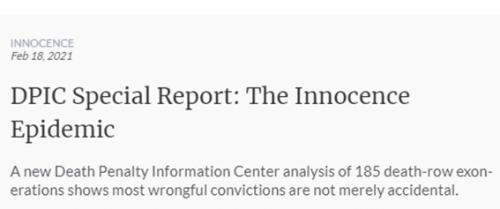23 February 2021 :
DPIC Adds Eleven Cases to Innocence List, Bringing National Death-Row Exoneration Total to 185.
New research by the Death Penalty Information Center has found 11 previously unrecorded death-row exonerations, bringing the total number of people exonerated after being wrongfully convicted and sentenced to death to 185. The data now show that for every 8.3 people who have been put to death in the U.S. since executions resumed in the 1970s, one person who had been wrongfully convicted and sentenced to death has been exonerated. Wrongful capital convictions occurred in virtually every part of the country, with exonerations documented in 29 states and 118 different counties.
“Everybody’s worst fear about capital punishment is that innocent people will be wrongfully convicted and executed,” said Robert Dunham, DPIC’s Executive Director. “But the more we learn about what actually happens in these cases, the worse the problem gets. As long as the legal system involves humans, it is guaranteed to make mistakes. But most innocent people who are wrongfully convicted and sent to death row don’t get there by mistake. The data from these 185 exonerations shows that far more frequently, and particularly with people of color, innocent death row prisoners were convicted because of a combination of police or prosecutorial misconduct and perjury or other false testimony.”
Analysis of the 185 innocence cases reveals disturbing patterns of official misconduct and racial bias. Nearly 70% of the exonerations involved misconduct by police, prosecutors, or other government officials. 80% of wrongful capital convictions involved some combination of misconduct or perjury/false accusation and more than half involved both. Cases that involved misconduct took longer, on average, to reach exoneration. Misconduct was implicated in all 8 of the exonerations that took more than 30 years and 88% of exonerations that took 21-30 years. Misconduct occurred more often in cases involving Black exonerees (78.8%) than white exonerees (58.2%). Black exonerees spent an average of 4.3 more years waiting for exoneration than white exonerees.
Jurisdictions with heavy use of the death penalty and histories of police and prosecutorial misconduct had the largest numbers of death-row exonerations. While 91 counties with wrongful capital convictions have produced one exoneration each, the 27 counties with multiple exonerations collectively account for a majority (50.2%) of the country’s death-row exonerations. Cook County (Chicago), Illinois wrongfully convicted and condemned 15 death-row exonerees since 1973, more than double the number of any other county in the United States. It is followed by Cuyahoga County (Cleveland), Ohio; and Philadelphia County, Pennsylvania, with six exonerations each. Maricopa County (Phoenix), Arizona; and Oklahoma County (Oklahoma City), Oklahoma had five each. By themselves, these five counties account for 37 death-row exonerations, one fifth of the nation’s total. And more than 95 percent of the wrongful capital convictions and death sentences in these counties involved some combination of police or prosecutorial misconduct and/or witness perjury or false accusation.
A new examination of exonerations involving DNA evidence suggests that many more innocence cases remain undetected because DNA evidence was unavailable or courts refused to permit testing. Because the presence or absence of DNA evidence in a case should have no effect on what factors cause a wrongful capital conviction, large differences between the causes of wrongful convictions in the DNA cases and in the cases with no DNA are red flags of where courts may have unjustly denied or erroneously credited false evidence that could have been disproven by DNA. In particular, misconduct, false or fabricated confessions, and questionable forensic or witness testimony were proven to be present much more frequently in the cases involving DNA evidence. Official misconduct was a contributing factor in 85.7% of exonerations involving DNA evidence, but only 66.2% of those without DNA. False or fabricated confessions were present 4.3 times more frequently in the DNA exonerations (46.4%) than in cases without DNA (10.8%), and false or misleading forensic evidence was exposed 2.9 times more frequently (71.4%) in the DNA cases than in the non-DNA exonerations (24.8%). Mistaken witness identifications were found more than twice as frequently in the DNA exonerations (35.7%) than in the exonerations without DNA (17.2%)
The DPIC analysis shows that DNA may be a critical element in uncovering innocence in wrongful conviction cases that might otherwise proceed to execution. Kirk Bloodsworth, Executive Director of Witness to Innocence and the first death-row survivor to be exonerated by DNA, said of the new report, “with such a large number of mistakes uncovered, there’s no need to wonder anymore, we can also be sure that innocent people have been executed.”
The eleven new cases are listed below:
- Anthony Carey (North Carolina), Black, convicted in 1973 and exonerated in 1974;
- Howard Jackson Stack (Georgia), White, convicted in 1973 and exonerated in 1975;
- John Thomas Alford (North Carolina), Black, convicted in 1975 and exonerated in 1976;
- Gary Radi (Montana), White, convicted in 1975 and exonerated in 1978;
- Thomas Pearson (Ohio), Nero, convicted in 1976 and exonerated in 1980;
- Charles Lee Bufford (Alabama), Black, convicted in 1978 and exonerated in 1981;
- Justin Cruz (Texas), Hispanic, convicted in 1984 and exonerated in 1985;
- Claude Wilkerson (Texas), White, convicted in 1979 and exonerated in 1987;
- Charles Tolliver (Ohio), Nero, convicted in 1986 and exonerated in 1988;
- Bonnie Erwin (Texas), Nero, convicted in 1985 and exonerated in 1989;
- Andre Minnitt (Arizona), Nero, convicted in 1993 and exonerated in 2002.
On the occasion of this article, the DPIC updates the various statistics of the Innocence List, such as the prevalence of Black prisoners (99) over Whites (67), the division by states and counties (Florida 30 exonerations, Illinois 21, Texas 16, 12 in North Carolina, 11 in Louisiana and Ohio, 10 in Arizona, Oklahoma and Pennsylvania, and below, grounds for convictions later overturned, and a brief account of each individual case.
DPIC also summarizes in a table the "errors" found in the cases:
Official Misconduct in 128 cases (69.2%)
False Confession in 30 cases (16.2%)
False or Misleading Forensic Evidence in 59 cases (31.9%)
Inadequate Legal Defense in 47 cases (25.4%)
Insufficient Evidence in 17 cases (9.2%)
Mistaken Witness Identification in 37 cases (20%)
Perjury or False Accusation in 125 cases (67.6%)
Exonerations Involving DNA in 28 cases (15.1%)







